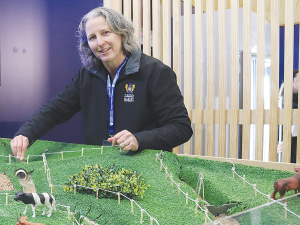Fonterra’s Pierre Venter named next vice chancellor of Massey University
The head of Fonterra's R&D facility in Palmerston North is set to literally cross the road and become the new vice chancellor at Massey University.
 Lucy Burkitt and interactive model showing the different ways to reduce nutrient and sediment loss to waterways.
Lucy Burkitt and interactive model showing the different ways to reduce nutrient and sediment loss to waterways.
There are a multitude of ways for farmers to reduce nutrient and sediment loss to waterways, but explaining this is a challenge.
At this year’s Fieldays, Massey University came up with a very simple and effective way of showing what’s possible by building an interactive model showing all the different ways.
Lucy Burkitt, a senior research officer at the School of Agriculture and the Environment at Massey, was literally swamped with people – students and farmers interested in the various options.
“The objective was to showcase some of the research we are doing and in particular the mitigation options that are available to farmers to try reduce nutrient and sediment loss to waterways,” she says.
The model is quite life-like in that it shows a typical rolling hillside complete with fences, animals etc and the different options are clearly shown. A feature, which attracted both young and old, was the option to press a button and set the irrigator in action.
The model shows variable rate irrigation, which Burkitt says is about the precise application of water to try and minimise nutrient loss particularly if the farm has different soil types.
“If there are paddocks closer to a waterway ideally a farmer might apply less water,” she explains.
The model shows fencing, riparian planting and controlled drainage, which allows the water to back up in the soil, resulting in denitrification – where the nitrate is converted into nitrogen gas that cleans the water. There is an example of wetlands and a wood chip bioreactor. In this case, water is collected in drains in a paddock and then put through the bioreactor where once again the nitrate is removed.
“We also show a detainment bund, which is at the bottom of a slope that allows ponding and for phosphorous to settle,” Birkett adds.
“We are also showcasing good practice with grazing management, which means leaving grass at the bottom of the slope so that it will capture some of the sediment.”
Burkitt says the model has worked well and has helped farmers to better understand some of the options that are available to them to deal with nutrient and sediment on their farm. She believes that the model will enable farmers to visualise what this all might look like.
As we move into the 2025/26 growing season, the Tractor and Machinery Association (TAMA) reports that the third quarter results for the year to date is showing that the stagnated tractor market of the last 18 months is showing signs of recovery.
DairyNZ chair Tracy Brown is urging dairy farmers to participate in the 2026 Levy vote, to be held early next year.
Beef + Lamb New Zealand (B+LNZ) is calling for nominations for director roles in the Eastern North Island and Southern South Island electoral districts.
Going one better than a frustratingly close second place finish at last year's event, the country's top axeman, Jack Jordan of Taumaranui, last weekend won the Stihl Timbersports World Championship individual event in.
Canterbury A&P Association (CAPA) show president Brent Chamberlain says a big development for this year is the Wool Zone, first introduced two years ago as a showplace for everything produced from wool, but now greatly enlarged with its own Wool Marquee and more than 30 trade sites.
Salmonellosis is a serious disease in cattle.

OPINION: Your old mate hears some of the farmers involved in the Meat Industry Excellence (MIE) group ten years ago…
OPINION: The Hound reckons the recent stoush about the old Broadcasting Standards Authority (BSA) expanding its brief – with no…